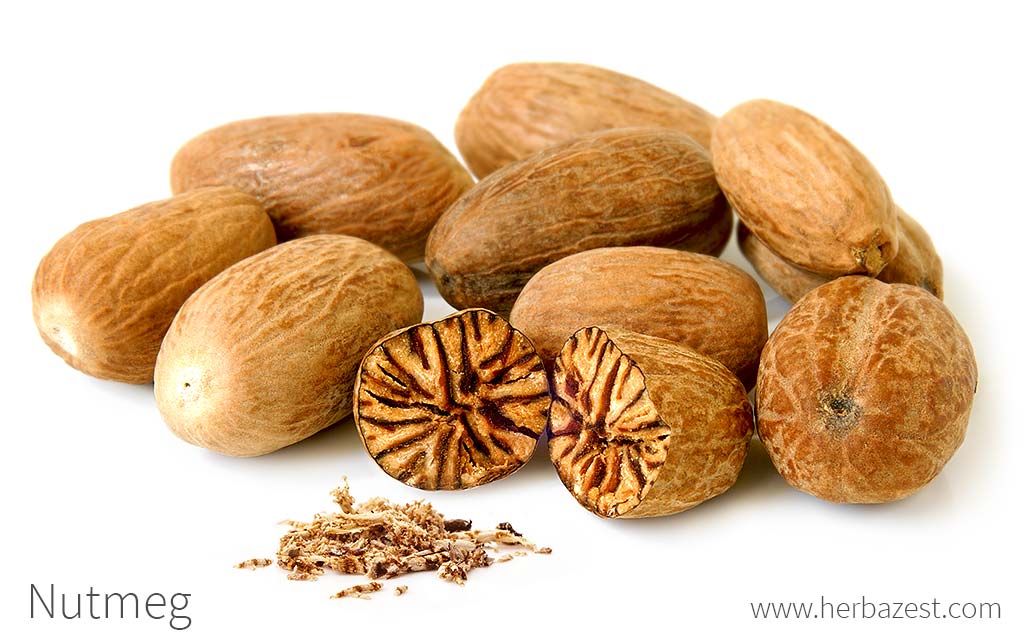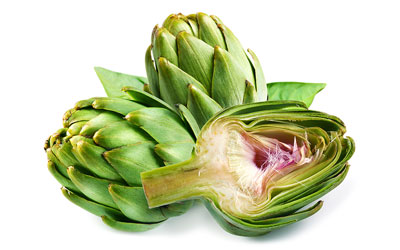The origins of this Southeast Asian spice can be traced to the Molucca Islands of Indonesia, where it still grows widely today. Though its products have traveled the globe, the nutmeg tree itself has not been naturalized to many other areas due to its restrictive growth requirements. Its common name derives from the Latin term for its seed, nux muscatus, meaning "musky nut," referring to its strong aroma.
Nutmeg Medicinal Properties
- Medicinal action Carminative, Appetite stimulant
- Key constituents Myrislignan, myristicin, methyl eugenol
- Ways to use Capsules, Liquid extracts, Food, Freshly ground, Essential oil, Dried
- Medicinal rating (1) Very minor uses
- Safety ranking Use with caution
Health Benefits of Nutmeg
Medicinally, nutmeg is known for being an anti-inflammatory, carminative, and stimulant agent. It has been traditionally used for:
Alleviating digestive issues. Nutmeg relieves gastrointestinal problems, including colic, diarrhea, flatulence, and indigestion.
Stimulating appetite. The volatile compounds of nutmeg seeds have an appetite-enhancing effect.
The Hindi, Chinese, and Arabian traditional medicine systems have taken advantage of nutmeg's properties, using it for digestive discomfort, headaches, fever, and even foul breath.
The antioxidant and antimicrobial health benefits of nutmeg also allow for its use in treating a variety of conditions, from infectious diseases and parasites to joint pain, vomiting, and neuropsychiatric disorders.
Nowadays, nutmeg is rarely administered alone, but its active compounds are used in numerous medicines.
How It Works
The benefits of nutmeg are attributed to many compounds, including myristic acid, trymiristin, fatty acid glyceride, monoterpenes, and phenylpropanoids. Nutmeg's most notable properties come from its essential oil (officially, Myristica oil or oleum myristicae), obtained by exposing the nuts to hydraulic pressure and heat.
The nutmeg seed has been widely used in Traditional Chinese Medicine for centuries, mainly for the treatment of gastrointestinal problems. Modern science has revealed that the active compound responsible for the carminative and other digestive properties of nutmeg is myrislignan, a neolignan with antiparasitic and anti-inflammatory activities.1
The appetite-enhancing effects of nutmeg are attributed to the inhalation of its volatile, aromatic compounds, mainly myristicin and methyl eugenol; however, the effects are short-lasting and usually lost by habituation. More studies are necessary to understand the mechanisms of action behind these properties.2,3
Additionally, nutmeg seed extracts have been shown to modulate monoamine neurotransmitters, the bioactive substances in the central nervous system, producing sedative and antidepressant effects.4,5
Herbs with similar carminative and digestive effects are cardamom, cinnamon and cloves, whereas dandelion, devil's claw, and lemon balm also stimulate appetite.
Nutmeg Side Effects
One of the active ingredients in the nutmeg seed, myristicin, besides its therapeutic benefits, has been proven to cause neurotoxic and hallucinogenic effects, and it is potentially fatal in large doses. Another nutmeg's constituent, safrole, can also be toxic when consumed in excessive amounts.
However, the nutmeg seed is considered safe when consumed ground in minimal, culinary doses with food. However, for medicinal purposes, it is best to consume nutmeg in controlled doses under medical supervision.

How to Consume Nutmeg
- Edible parts Seed
- Edible uses Flavoring, Sweetener
- Taste Aromatic
In spite of the existence of supplemental forms on the herbal medicine market, nutmeg is almost exclusively used for culinary purposes as a spice. It is a very common ingredient in several different cuisines, appearing in curries and rice dishes in its native regions as well as savory dishes in the Middle East, beverages in the Caribbean region, and traditional holiday dishes throughout Europe and North America. In Scotland, it is an essential ingredient in haggis, the country's most traditional meal.
Natural Forms
Dried. The whole nutmeg seed is usually grated to be added to a variety of culinary preparations. This a popular way of reaping the carminative and anti-inflammatory benefits of this aromatic spice.
Powder. In a more practical way, nutmeg powder can be directly added to foods and lattes in order to obtain its medicinal properties.
Herbal Remedies & Supplements
Essential oil. Also known as Myristica oil, it is considered the most useful way to consume nutmeg for medicinal purposes. Suggested safe uses include inhalation to stimulate appetite, or topical application in order to soothe joint pain and muscle fatigue. It also can be diluted and rubbed over the abdomen and feet to relieve pain and discomfort.
Liquid extract. In this supplemental form, nutmeg can be diluted in a glass of water, juice, or other drink of preference and ingested to alleviate gastrointestinal problems and even insomnia thanks to its mild sedative properties. However, it is recommended to consult to a physician before consuming any herbal tinctures for therapeutic purposes.
Capsules. Under medical supervision, nutmeg capsules are generally considered safe for ingestion in therapeutic doses in order to reap their medicinal benefits.
Myristica oil can be toxic when ingested, so it's not recommended to use it in this way without previously consulting to a healthcare practitioner.
Growing
- Life cycle Perennial
- Harvested parts Seeds
- Light requirements Full sun, Partial shade
- Soil Peaty
- Soil pH 6.1 – 6.5 (Slightly acidic), 6.6 – 7.3 (Neutral)
- Growing habitat Tropical rainforests
- USDA Plant Hardiness Zones 10a, 10b, 11a, 11b
- Plant spacing average 0.9 m (2.95 ft)
- Potential diseases Fungi, Leaf spot
Large-scale nutmeg cultivation efforts have been successful for hundreds of years; however, as it is not a common ornamental plant, many factors exist that may forestall seed production.
Growing Guidelines
The nutmeg tree depends on tropical forest conditions and will not tolerate temperatures under 55°F (13°C).
For optimal growth, the nutmeg plant requires well-drained and slightly acidic soil, which must be kept from both drying out and water-logging.
Nutmeg trees can be grown directly from the seed in a nursery and then transplanted to a sunny area.
It takes approximately six to nine years for a nutmeg tree to begin fruiting and 20 years to reach maturation.
Seeds from male and female trees are indistinguishable until maturation, but only female trees produce seeds, yielding 10,000 each season of its potentially 100-year-long life.
The nutmeg tree is vulnerable to fungal infestations and leaf spots.
AN EVERGREEN TREE, NUTMEG GROWS BEST IN ITS NATIVE TROPICAL CLIMATE.
Additional Information
- Other uses Animal feed, Cosmetics, Fuel, Soapmaking
Plant Biology
The nutmeg tree is a tropical evergreen that can reach up to 60 feet (18 m), with entire oval leaves up to 10 inches (25 cm) long. Its round fruit is about two inches (5 cm) long and contains one large seed, which is surrounded by a red aril, known as "mace," that turns yellow when dried. Both nutmeg and mace have been used by humans, but mace is considered more medicinal today.
Classification
Belonging to Myristicaceae, or the nutmeg family, Myristica fragrans is one of 440 species of flowering plants growing in chiefly tropical regions.
Varieties and Subspecies of Nutmeg
Though the nutmeg tree produces two separate commodities: nutmeg (the seed,) and mace (the delicate covering on the kernel), it does not have any subspecies or varying cultivars. This is most likely due to its restricted areas of growth, little modern demand for variety, and its lack of use as an ornamental plant.
Historical Information
Nutmeg was first used in its native regions as a seasoning and medicinal herb for an unknown number of generations, but by the 1st century CE, it was so widespread that its trade went as far west as classical Greece and Rome.
During the 11th century, the spice was praised for its effect on the kidneys, and it was used to combat digestive disorders, pain, vomiting, and lymphatic ailments, and it was even considered aphrodisiac. Dating back to the 16th century, nutmeg was known for its psychoactive properties and used as an antidepressant and hallucinogenic. Nutmeg's hallucinogenic properties are well documented by historic figures, including Malcolm X, but despite that, it remains a popular spice for seasoning in small amounts to this day.
Economic Data
As a large-scale cultivation crop, nutmeg represents an important source of revenue in many Southeast Asian countries, exported primarily as a culinary spice. Guatemala, however, currently outranks them all as top producer, generating over 31% of the world's supply and just surpassing Indonesia's annual yield of 24,000 tons. Despite lesser quantity, seeds that come from Grenada are prized above all others for their superior quality, driving up mean import prices in the U.S. to over $11 million USD per year due to limited supplies.
Other Uses
Personal care industry. Nutmeg oil is used in soaps and cosmetics.
Fuel. Nutmeg shells have shown promise as a source of bio fuel that can be be burned as briquettes and may substitute coal and charcoal.
Fodder. The subproducts of the nutmeg and mace production also make good source of food for farm animals.
Nutmeg oil also has several folk uses. A massage oil is obtained by diluting nutmeg essential oil in almond oil and used to relieve muscular pains associated with rheumatism or overexertion, as well as for an emergency treatment to dull toothache. Drops are put on a cotton swab and applied to the gums around an aching tooth until dental treatment can be obtained.
Sources
- Drugs and Lactation Database, Nutmeg Review, 2006
- Government of India, Department of Export: Nutmeg
- Health & Environmental Research Online (HERO), Antioxidant, antimicrobial, and health benefits of nutmeg
- International Journal of Phytotherapy Research, ANXIOLYTIC EFFECT OF MYRISTICA FRAGRANS, 2013
- Molecules, Utilization of Nutmeg (Myristica fragrans Houtt.) Seed Hydrodistillation Time to Produce Essential Oil Fractions with Varied Compositions and Pharmacological Effects, 2020
- North American Journal of Medical Sciences, Histological effects of long term consumption of nutmeg on the medial geniculate body of adult Wistar rats, 2010
- Phytochemistry Reviews, Chemical diversity and pharmacological significance of the secondary metabolites of nutmeg (Myristica fragrans Houtt.), 2017
- Purdue University, Nutmeg and Mace
- United Nations Office on Drugs and Crime, The use of nutmeg as a psychotropic agent
- FAOSTAT, Nutmeg, Mace, and Cardamoms
- Healthy Smoothie Recipes
- The Psychopharmacology of Herbal Medicine
Footnotes
- RSC Advances. (2017). Metabolic profiling of myrislignan by UPLC-ESI-QTOFMS-based metabolomics. Retrieved February 21, 2023, from: https://pubag.nal.usda.gov/catalog/6420444
- Molecules. (2021). Pharmacological and Therapeutic Potential of Myristicin: A Literature Review. Retrieved February 21, 2023, from: https://www.ncbi.nlm.nih.gov/pmc/articles/PMC8512857/
- Journal of Natural Medicine. (2019). Appetite-enhancing effects of nutmeg oil and structure-activity relationship of habituation to phenylpropanoids. Retrieved February 21, 2023, from: https://pubmed.ncbi.nlm.nih.gov/30919203/
- Phytotherapy Research. (2013). Formulas used by Tibetan doctors at Men-Tsee-Khang in India for the treatment of neuropsychiatric disorders and their correlation with pharmacological data. Retrieved February 21, 2023, from: https://pubmed.ncbi.nlm.nih.gov/22674653/
- Avicenna Journal of Phytomedicine. (2012). Evaluation of the anti-depressant activity of Myristica fragrans (Nutmeg) in male rats. Retrieved February 22, 2023, from: https://www.ncbi.nlm.nih.gov/pmc/articles/PMC4075663/










